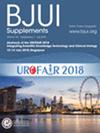Incidence and risk factors for postoperative vaginal events following radical cystectomy for bladder cancer: a nationwide population-based study.
IF 4.4
2区 医学
Q1 UROLOGY & NEPHROLOGY
引用次数: 0
Abstract
OBJECTIVE To estimate the probability of vaginal events (diagnosis and/or surgery) following radical cystectomy (RC) and explore possible risk factors in a nationwide population-based observational registry based study. PATIENTS AND METHODS Women undergoing RC for urinary bladder cancer in Sweden, from 1 January 1997 to 31 December 2019, were identified within national registries. Women with any postoperative vaginal event (PVE), either a diagnosis or surgical repair related to a vaginal complication, were identified using diagnostic and treatment codes. The probability of developing a PVE was estimated based on the cumulative incidence proportion using a competing risk model. Additionally, a multivariable Cox proportional hazards model was used to explore the risk factors for PVEs. Subgroup analysis was performed in patients operated from 2011 to 2019, where additional perioperative variables were registered. RESULTS The study encompassed 1914 women with a median age of 69 years at the time of bladder cancer diagnosis. The 5-year cumulative risk of PVEs in the entire cohort was 11% (95% confidence interval [CI] 9.5-12.5%). Subgroup analysis showed that robot-assisted RC and a body mass index (BMI) >30 kg/m2 were more often associated with PVEs after RC (hazard ratio [HR] 2.82, 95% CI 1.81-4.40; and HR 1.71, 95% CI 1.05-2.79, respectively). CONCLUSIONS A clinically relevant cumulative incidence of PVEs following RC was identified. An association between robot-assisted RC or high BMI with increased risk of a PVE indicate the need for further studies on risk assessment of vaginal complications.膀胱癌根治性膀胱切除术后阴道事件的发生率和危险因素:一项基于全国人群的研究
目的:在一项以全国人口为基础的观察性登记研究中,估计根治性膀胱切除术(RC)后阴道事件(诊断和/或手术)的概率,并探讨可能的危险因素。患者和方法:从1997年1月1日至2019年12月31日,在瑞典国家登记处确定了接受膀胱癌RC的女性。使用诊断和治疗代码确定任何阴道术后事件(PVE)的妇女,无论是与阴道并发症相关的诊断还是手术修复。采用竞争风险模型,基于累积发生率估计PVE发生的概率。此外,采用多变量Cox比例风险模型探讨pve的危险因素。对2011年至2019年手术的患者进行亚组分析,登记其他围手术期变量。结果该研究纳入了1914名膀胱癌诊断时中位年龄为69岁的女性。整个队列中pve的5年累积风险为11%(95%可信区间[CI] 9.5-12.5%)。亚组分析显示,机器人辅助RC和体重指数(BMI) bb0 ~ 30 kg/m2更常与RC后pve相关(风险比[HR] 2.82, 95% CI 1.81 ~ 4.40;风险比[HR] 1.71, 95% CI 1.05 ~ 2.79)。结论确定了术后pve的临床相关累积发生率。机器人辅助RC或高BMI与PVE风险增加之间的关联表明需要进一步研究阴道并发症的风险评估。
本文章由计算机程序翻译,如有差异,请以英文原文为准。
求助全文
约1分钟内获得全文
求助全文
来源期刊

BJU International
医学-泌尿学与肾脏学
CiteScore
9.10
自引率
4.40%
发文量
262
审稿时长
1 months
期刊介绍:
BJUI is one of the most highly respected medical journals in the world, with a truly international range of published papers and appeal. Every issue gives invaluable practical information in the form of original articles, reviews, comments, surgical education articles, and translational science articles in the field of urology. BJUI employs topical sections, and is in full colour, making it easier to browse or search for something specific.
 求助内容:
求助内容: 应助结果提醒方式:
应助结果提醒方式:


